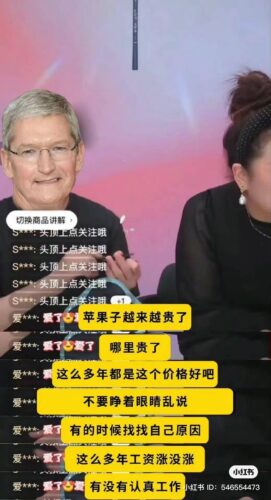“Is Apple running out of tricks? There is no significant difference between the iPhone 14 and iPhone 15,” said one Weibo user.
“Thank you Apple for saving money for me!” another person wrote, implying that the new devices aren’t impressive enough to buy.
Not all the gripes, however, were about technical improvements. For years, Apple has relied on a vast manufacturing network in China to mass produce the iPhone, iPad, and other popular products found in households around the world. But its dependance on the country was tested during the COVID-19 pandemic.
Apple has slowly been moving manufacturing away from China and into new facilities in India. While the vast majority of iPhone 15s will still come from China, the company is reportedly set to make India-built iPhone 15 units available to purchase in the South Asian country and “some other regions” on September 22.
The migration didn’t go unnoticed by Chinese internet users. Commenting on the new iPhones, a number of Weibo users raised questions about their origins, arguing that they weren’t confident about the quality of India-built devices. “Is there a way to avoid made-in-India iPhones?” one person asked on Weibo, to which another one replied, “If you don’t buy it, the chance of getting an India-assembled iPhone is zero.”
Others said they were put off by the price hike. In the U.S., the prices for all of the devices and different storage configurations within the iPhone 15 family remained the same versus the iPhone 14. But in China, although the prices for the basic versions of the iPhone 15, iPhone 15 Plus, and iPhone 15 Pro Max remained the same, consumers will see higher costs for upgraded storage options. For example, the 512-gigabyte version of the iPhone 15 has gone up by 300 yuan ($41) compared with the iPhone 14.
According to CNBC, Apple also raised the price of every model of the iPhone 15 in India. The Indian rupee and Chinese yuan have depreciated against the U.S. dollar in the last year, so the American company had to raise prices in these currencies in order to keep prices constant in dollar terms.
“I know it’s not Apple’s fault. It’s my fault,” one person joked, referring to a recent controversy involving shopping influencer Lǐ Jiāqí 李佳琦, who came under fire this week after a recent online broadcast where he told viewers complaining about pricing to work harder.
“Sometimes you have to reflect on yourself and ask why you haven’t received a raise after so many years,” read the text on an image that’s been widely shared online, where Apple CEO Tim Cook’s is photoshopped onto a screenshot of Li’s controversial livestream session.

The unfavorable response to the iPhone 15 series is bad news for Apple, whose shares slipped last week after several reports said that Chinese government agencies and state firms were banning staff from using iPhones to comply with Beijing’s campaign to cut reliance on foreign technology and enhance cybersecurity. In the worst two-day slump in a month for Apple, the company’s shares dropped 6.4%, wiping out nearly $200 billion of market value.
On Wednesday, Máo Níng 毛宁, a spokeswoman for the Foreign Ministry, denied the rumored ban while stressing that Beijing had noticed “numerous media reports on security incidents involving Apple smartphones.” While Mao didn’t elaborate, she appeared to be referring to an urgent security update issued by Apple last week, after it was warned about a previously unknown vulnerability that allowed Israel’s NSO Group to plant its Pegasus spyware remotely in iPhones and iPads.
“We have always been open to foreign companies and welcome them to seize the opportunities and share the fruits of China’s economic development,” Mao told reporters at a regular media briefing. “China has not issued laws, regulations, or policy documents that prohibit the purchase and use of foreign brand phones such as Apple’s.”
However, despite the denial, some commenters revealed on Chinese social media that such restrictions had already been implemented by certain local governments, though they weren’t communicated in writing. “Sometimes a message can be conveyed in a subtle way,” a Douyin user wrote, adding that a few civil servants they know have already ditched iPhones, given “the direction the wind is blowing,”
The Greater China region — covering the mainland, Hong Kong, Taiwan, and Macau — is Apple’s third-largest market, accounting for 18% of its total revenue of $394 billion last year. Thanks to “the large user base and strong customer stickiness for Apple” in China, Will Wong, a senior research manager at IDC, said that it might be too soon to call the iPhone 15 series a flop in the country.
“Having more buzz, indeed, is good for the company,” he told The China Project. “But the biggest question that needs to be asked is how much of this buzz could be converted to actual buyers.”
According to IDC, a global market research firm that tracks the smartphone industry, for the second quarter of 2023, Apple enjoyed a market share of over 65% in the segment of high-end smartphones among Chinese consumers, with its homegrown rival Huawei trailing far behind at 18%.
The gap is likely to narrow in the near future, though. Earlier this month, in a unusually low-key fashion, Huawei launched the presale of the Mate 60 Pro, a Chinese smartphone that has the speed to match a 5G device and is believed to be powered by a cutting-edge made-in-China microchip developed by the country’s top contract chipmaker, Semiconductor Manufacturing International Corporation (SMIC).
With no prior advertising, the news sparked a groundswell of patriotic fervor across Chinese social media, with state-affiliated publications wasting no time to hail the model as a symbol of China’s technological progress in the face of American attempts to undermine China by restricting its access to sophisticated chips.
Outside China, Huawei’s new gadget raised eyebrows among industry experts, who questioned how SMIC, which is headquartered in Shanghai, managed to produce such a chip, four years after the U.S. began imposing export restrictions to hinder China’s access to powerful technology.
During a White House press briefing on September 5, U.S. National Security Adviser Jake Sullivan urged the government to seek more information about precisely the phone’s “character and composition” to determine if there was a sanctions violation. In response, the U.S. Department of Commerce, which has authored most of the sanctions imposed on Huawei and SMIC, said last week that it had launched an official probe into the controversial chip.
“Let’s be clear: export controls are just one tool in the U.S. government’s toolbox to address the national security threats presented by the P.R.C.,” a Commerce spokesperson said in a statement. “The restrictions in place since 2019 have knocked Huawei down and forced it to reinvent itself — at a substantial cost to the P.R.C. government.”
“The Huawei Mate 60 series is expected to bring a challenge to Apple,” said Wong, who also noted that “the soft consumer demand for smartphones is also expected to bring another challenge” to the American brand.
On the Chinese internet, the rivalry between Huawei and Apple — specifically the new flagship smartphone lineups recently introduced — has been framed as a technology competition between China and the U.S. Meanwhile, the Shenzhen-based company has increased its shipment target for the Mate 60 series in the second half of 2023 by 20%, with expectations that the new smartphone shipments for the entire year will reach at least 40 million units.
>>> Read full article>>>
Copyright for syndicated content belongs to the linked Source : SupChina – https://thechinaproject.com/2023/09/15/apples-2023-product-launch-event-receives-tepid-response-in-china/














![[News] Japan Develops 10nm Nanoimprint Technology, with Potential to Tackle EUV Bottleneck – TrendForce](https://earth-news.info/wp-content/uploads/2025/12/329851-news-japan-develops-10nm-nanoimprint-technology-with-potential-to-tackle-euv-bottleneck-trendforce-360x180.jpg)















